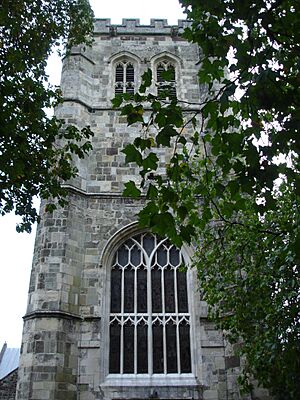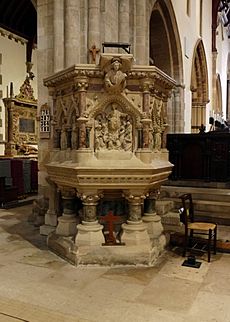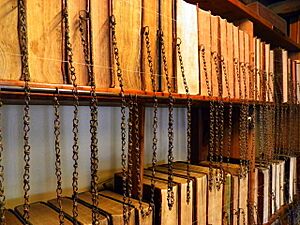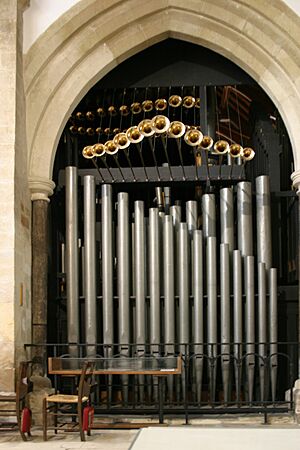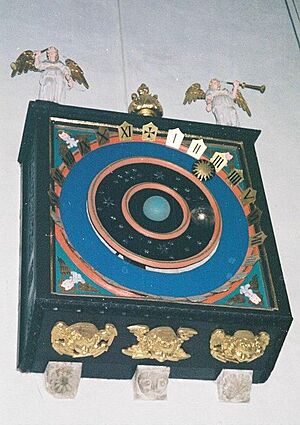Wimborne Minster (church) facts for kids
Quick facts for kids Wimborne Minster |
|
|---|---|
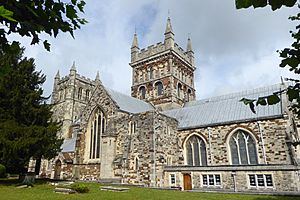 |
|
| Country | England |
| Denomination | Church of England |
| History | |
| Dedication | Saint Cuthburga |
| Specifications | |
| Tower height | Central Tower: 84 ft (26 m) West Tower: 95 ft (29 m) |
| Bells | 13 change ringing bells, 2 clock bells |
| Tenor bell weight | 29 long cwt 2 qr 20 lb (3,324 lb or 1,508 kg) |
| Administration | |
| Parish | Wimborne Minster |
| Diocese | Salisbury |
| Province | Canterbury |
Wimborne Minster is a very old and special church in Wimborne, Dorset, England. It has been around for more than 1300 years! This church is famous for its unique chained library, which is a library where books are literally chained to the shelves. It is one of the few chained libraries still existing in the world. The minster used to be a monastery and a place for nuns. King Æthelred of Wessex is buried here.
Contents
A Look Back: The Minster's History
Wimborne Minster has a long and interesting past. It started as a religious community and grew over many centuries.
How Wimborne Abbey Began
The minster is named after Saint Cuthburga. She was the sister of King Ine of Wessex. Around the year 705, Saint Cuthburga started a Benedictine abbey for nuns here. Two other important women, Saint Walpurga and Leoba, were also educated at this monastery. Walpurga stayed for 26 years before traveling to Germany to help with missionary work.
A monastery for men was also built nearby around the same time. Over the next 100 years, both the abbey and the monastery became very important. The old Anglo-Saxon name for this place was Winburna.
In 871, King Æthelred I of Wessex was buried at the minster. He was the older brother of Alfred the Great. Later, in 899, Æthelred's son, Æthelwold, tried to become king. He took a nun, probably from Wimborne, and made a stand here. He likely chose this spot because his father was buried there. However, he did not get enough support and had to leave.
Becoming a Collegiate Church
In 1013, the women's monastery was destroyed by the Danes. It was never rebuilt. However, the main abbey building survived. In 1043, Edward the Confessor started a college of priests, called canons, at the minster. This group included a dean, four prebends, four vicars, four deacons, and five singers.
The minster was rebuilt and changed by the Normans between 1120 and 1180. This was done to support the new college of priests.
In 1318, King Edward II made the minster a "royal peculiar." This meant it was free from the usual church rules of the area. Because of this, the choir members used to wear special scarlet robes. You can see similar robes at Westminster Abbey and St George's Chapel at Windsor Castle.
In 1496, Lady Margaret Beaufort, who was the great-granddaughter of John of Gaunt and mother of King Henry VII, built a small chapel in the minster. When King Henry VIII was in power, the remaining parts of the monastery became part of the minster. This helped them avoid being destroyed. However, King Henry VIII took much of the minster's wealth.
In 1562, Queen Elizabeth I gave back some of the minster's property and rights to Wimborne. These were given to twelve governors. Later, in 1625, King Charles I gave a new charter, adding an organist and singers. During the English Civil War, when King Charles I was executed, his coat of arms was painted over in the minster. But when Charles II became king, the arms were quickly put back. They have been restored since then.
In 1846, the "royal peculiar" status was removed. Today, 12 governors still help manage some of the minster's affairs. The church was renovated in the late 1800s. Its last addition, a vestry, was built around that time. Today, Wimborne Minster is a place for worship and visits for both local people and tourists.
The Minster's Design and Structure
The main part of the minster, including its central tower and nave, started in Saxon times. However, most of the building you see today is Norman in style. It also has parts added later in the Gothic style.
One of its most famous features is a working astronomical clock. This clock rings every hour and has a colorful figure called a quarterjack. The minster is built using local Dorset limestone and stone from the New Forest.
The central part of the minster is about 198 feet long. The width of the main area is about 23 feet in the nave and 21 feet in the choir. The western tower is 95 feet tall. The smaller tower, above the transepts, is 84 feet tall. A 13th-century spire used to be on top of this smaller tower. It fell down in a storm around the year 1600.
Wimborne Minster is a Grade I listed building. This means it is a very important historical building.
The Chained Library: Books on Chains
Before King Henry VIII took control, the old Treasury held the minster's valuable items. These included many artifacts, like a piece said to be from the true cross.
Since 1686, the minster has been home to an important chained library. This library was one of the first public libraries in the UK. It is still the second-largest chained library today. Some of its special collections include:
- A manuscript written on lambskin in 1343.
- A book made for the court of Henry VIII.
- A very old book, printed in 1495, about the works of Saint Anselm.
- A book called "Paraphrase of Erasmus," printed in 1522. Its title page was designed by the famous artist Holbein.
Volunteers run the library. It is open to the public on weekdays from 10:30 AM to 12:30 PM and from 2:00 PM to 4:00 PM. It is closed during the winter.
The Minster's Bells
Since 1911, the west tower of the minster has held a set of ten bells. The original largest bell was in the central tower and was made in 1385. The central tower was not strong enough for more heavy bells. So, in 1464, the west tower was built to hold five bells. In 1629, the largest bell was remade.
Besides the largest bell, the minster also had bells named 'Bell of St. Cuthburga,' 'The Fyfer Bell,' 'The Jesus Bell,' and 'The Morrow Mass Bell.' These were likely all in the west tower. In 2012, more bells were added by the Whitechapel Bell Foundry. This brought the total to 13 bells.
The Organ: Music in the Minster
The minster's organ was first built in 1664 by Robert Hayward. Some of the pipes from that original organ are still used today. The organ used to stand on a screen that separated the nave from the choir. In 1856, the organist moved it to the south choir aisle.
J. W. Walker & Sons rebuilt and made the organ larger in 1866. They did more work in 1899, adding a new case for the Choir Organ. This case was designed by Walter J. Fletcher. In 1965, the organ was greatly rebuilt and redesigned again by J. W. Walker & Sons.
In 2021, Mander Organ Builders started rebuilding the organ. This project will change how the instrument is organized. It will include two new cases, a new air system, and a new 32-foot pedal Sub Bass. This work was expected to be finished in early 2022.
The Astronomical Clock
Wimborne Minster is home to a special Wimborne Minster Astronomical Clock. It is one of several famous astronomical clocks from the 14th to 16th centuries found in western England. Other similar clocks are in Salisbury, Wells, Exeter, and Ottery St Mary.
The clock's outer case was built during the Elizabethan era. However, the face and dial are much older. The first records about repairs to the clock date back to 1409. The clock face shows a pre-Copernican view of the universe. This means it shows the Earth in the center, with the sun and stars orbiting around it.
A local resident, Bruce Jensen, currently takes care of the clock.
Important Tombs and Burials
The most important tomb in the church belongs to King Ethelred. He was the brother of Alfred the Great. King Ethelred was badly hurt in a battle near Cranborne. We do not know the exact spot of his tomb, but stories say it is somewhere near the altar. A metal memorial from the 14th century next to the altar says the former king is buried in the wall. This is the only brass memorial marking the burial site of an English king.
Two other important tombs are also in the minster. These are for John Beaufort, 1st Duke of Somerset, and his duchess. They were the grandparents of King Henry VII. Their tombs are made of alabaster and Purbeck Marble.
Other people buried at Wimborne Minster include:
- Cuthburh
- Gertrude Courtenay, Marchioness of Exeter
- Montague Druitt
Images for kids


